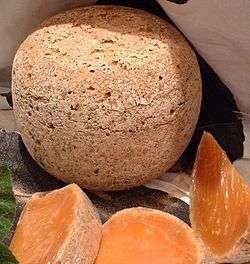Mimolette
| Mimolette | |
|---|---|
 | |
| Country of origin | France |
| Region, town | Nord, Lille |
| Source of milk | Cows |
| Pasteurized | Yes |
| Texture | Hard |
| Aging time | 2 Months – 2 Years |
| Certification | – |
|
| |
Mimolette is a cheese traditionally produced around the city of Lille, France. In France, it is also known as Boule de Lille after its city of origin, or vieux Hollande for being made after the tradition of Edam cheese. In some areas of Belgium and the Netherlands,[1] such as Flanders, it is also known as commissiekaas.
It was originally made by the request of Louis XIV, who – in the context of Jean-Baptiste Colbert's mercantilistic policies – was looking for a native French product to replace the then very popular Edam. To make it distinct from Edam he seasoned it with annatto to give it a sweet and nutty flavor and a distinct orange color.
It normally weighs about 2 kg (approximately 4.5 pounds) and is made from cow's milk. Its name comes from the French word molle, meaning "soft". This refers to the softness of the crust when young – with age it becomes harder. It has a grey crust and orangish flesh. The orange color comes from the natural seasoning, annatto, which has a sweet and nutty flavor. The cheese has a similar appearance to a cantaloupe melon.
The greyish crust of aged Mimolette is the result of cheese mites intentionally introduced to add flavor by their action on the surface of the cheese.
Mimolette can be consumed at different stages of aging. When younger, its taste resembles that of Parmesan. Many appreciate it most when "extra-old" (extra-vieille). At that point, it can become rather hard to chew, and the flesh takes a hazelnut-like flavour.
The cheese was known to be a favorite of French President, Charles De Gaulle.
Health concerns in the U.S.
In 2013, the Food and Drug Administration detained about a ton of the cheese, putting further imports to the United States on hold. This was because the cheese mites could cause an allergic reaction if consumed in large quantities. The FDA stated that the cheese was above the standard of six mites per cubic inch.[2]
See also
| Wikimedia Commons has media related to Mimolette. |
- Milbenkäse
- Casu marzu
- List of cheeses
-
 Food portal
Food portal
References
- ↑ Jenkins, Steven (1996). Cheese Primer. Workman Publishing Company. pp. 64, 65. ISBN 978-0-89480-762-6.
- ↑ "Mimolette imports on hold". SFGate. Retrieved 2016-05-19.